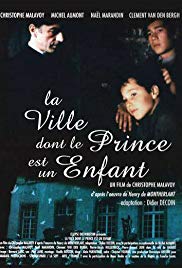
LA VILLE DON LE PRINCE EST UN ENFANT/ THE FIRE THAT BURNS
France, 1997, 90 minutes, Colour.
Christophe Malavoy, Michel Aumont, Nael Marandin, Clement van den Berg.
Directed by Christophe Malavoy.
This film of 1997 is based on a play from 1951 by Henry de Monthalant and keeps that setting. This is a Catholic Church story, the setting in a boarding school for boys.
The atmosphere of Catholicism is that of pre-Vatican II. The clergy are on a pedestal although this is the kind of film that contributed to something of the toppling of pedestals.
The school is rather isolated. There is a superior, often seen watching the boys and the staff, an interesting performance and presence by Michel Aumont.
The film gives quite some attention to the boys in the school, the range of ages, classes, sports, a variety of activities. It also shows the priests on the staff but concentrates on the one, Abbe de Pradts, played by the director of the film, Christophe Malavoy.
The other focus is on two of the boys, a difference of age of several years between them, but a strong friendship, intimations of homosexuality, the older boy strong minded, the younger boy, even more strong minded and self-assertive, with the friendship and with the dealings with de Pradts.
This is the period of a number of stories about priests – and the story was published at the time of the release of Robert Bresson’s film Diary of a Country Priest.
There is very little background to de Pradt. He is moving into middle age, has been a priest for some time, takes his work very seriously, but devotes a great deal of his attention to the boys, the Superior thinking that he spends too much time with the boys. Towards the end of the film, there is quite some serious discussion between the two priests, psychological in many ways, but rather cerebral in terms of the language, the ideas, relationship between adults and children, the role of the male adult educator and the children, the demands of celibacy, spiritual aspects of priesthood.
The film does not reach dramatic conclusions but leaves the reflections for the consideration of the audience.
The film was made in France at the time, the 1990s, when there was more focus in the church, and more focus in films, on schools and sexual abuse.